The Effects of Runoff and Erosion Hydrodynamics by Check Dams Under Different Precipitation Types in the Watershed of Loess Plateau
Abstract
1. Introduction
2. Model Establishment
2.1. Study Area
2.2. MIKE-SHE Model Construction
2.2.1. Model Scope and Grid Division
2.2.2. Watershed Terrain Setting
2.2.3. The Slope Flow Module
2.3. MIKE-11 Model Construction
- (1)
- The river network file (*.nwk11)
- (2)
- The cross-section file (*.xns11)
- (3)
- The boundary file (*.bnd11)
- (4)
- Dynamic parameter file (*.hd11)
2.4. Calibration and Validation
2.5. Simulation Scenario Setting
- (1)
- Conditions of check dam system construction
- (2)
- Determination of model precipitation conditions
3. The Regulating Effect of Check Dam Systems on Runoff Process
4. The Influence of Check Dam Systems on the Erosion Dynamics of Channels
4.1. Temporal and Spatial Differences in Channel Velocity
4.1.1. Spatial Character
4.1.2. Temporal Character
4.2. Temporal and Spatial Differences in Channel Runoff Shear
4.2.1. Spatial Character
4.2.2. Temporal Character
4.3. Temporal and Spatial Differences in Channel Runoff Power
4.3.1. Spatial Character
4.3.2. Temporal Character
5. Discussion
5.1. Runoff Process Regulation
5.2. Erosion Power Regulation
5.3. Limitations and Implications
6. Conclusions
Author Contributions
Funding
Data Availability Statement
Conflicts of Interest
References
- Xia, L.; Bi, R.; Song, X.; Hu, W.; Lyu, C.; Xi, X.; Li, H. Soil Moisture Response to Land Use and Topography across a Semi-Arid Watershed: Implications for Vegetation Restoration on the Chinese Loess Plateau. J. Mt. Sci. 2021, 19, 103–120. [Google Scholar] [CrossRef]
- Feng, Z.; Li, Z.; Shi, P.; Li, P.; Wang, T.; Duan, J. Impact of Sedimentation by Check Dam on the Hydrodynamics in the Channel on the Loess Plateau of China. Nat. Hazards 2021, 107, 953–969. [Google Scholar] [CrossRef]
- Clilverd, H.M.; Thompson, J.R.; Heppell, C.M.; Sayer, C.D.; Axmacher, J.C. Coupled Hydrological/Hydraulic Modelling of River Restoration Impacts and Floodplain Hydrodynamics. River Res. Appl. 2016, 32, 1927–1948. [Google Scholar] [CrossRef]
- Gao, H. Study on the Eco-Hydrological Effects of Gully Control Engineering in the Hilly and Gully Region of the Loess Plateau. Ph.D. Thesis, Graduate University of Chinese Academy of Sciences (Research Center for Soil and Water Conservation and Ecological Environment, Ministry of Education), Beijing, China, 2013. [Google Scholar]
- Fu, B.; Liu, Y.; Lü, Y.; He, C.; Zeng, Y.; Wu, B. Assessing the Soil Erosion Control Service of Ecosystems Change in the Loess Plateau of China. Ecol. Complex. 2011, 8, 284–293. [Google Scholar] [CrossRef]
- Bai, L.; Wang, N.; Jiao, J.; Chen, Y.; Tang, B.; Wang, H.; Chen, Y.; Yan, X.; Wang, Z. Soil Erosion and Sediment Interception by Check Dams in a Watershed for an Extreme Rainstorm on the Loess Plateau, China. Int. J. Sediment Res. 2020, 35, 408–416. [Google Scholar] [CrossRef]
- Shi, P.; Zhang, Y.; Ren, Z.; Yu, Y.; Li, P.; Gong, J. Land-Use Changes and Check Dams Reducing Runoff and Sediment Yield on the Loess Plateau of China. Sci. Total Environ. 2019, 664, 984–994. [Google Scholar] [CrossRef]
- Li, P.; Xu, G.; Lu, K.; Zhang, X.; Shi, P.; Bai, L.; Ren, Z.; Pang, G.; Xiao, L.; Gao, H.; et al. Runoff Change and Sediment Source during Rainstorms in an Ecologically Constructed Watershed on the Loess Plateau, China. Sci. Total Environ. 2019, 664, 968–974. [Google Scholar] [CrossRef]
- Stone, M.C.; Byrne, C.F.; Morrison, R.R. Evaluating the Impacts of Hydrologic and Geomorphic Alterations on Floodplain Connectivity. Ecohydrology 2017, 10, e1833. [Google Scholar] [CrossRef]
- Wang, Z.; Chen, Z.; Yu, S.; Zhang, Q.; Wang, Y.; Hao, J. Erosion-Control Mechanism of Sediment Check Dams on the Loess Plateau. Int. J. Sediment Res. 2021, 36, 668–677. [Google Scholar] [CrossRef]
- Turkyilmazoglu, M. Evidence of Stretching/Moving Sheet-Triggered Nonlinear Similarity Flows: Atomization and Electrospinning with/without Air Resistance. Int. J. Numer. Methods Heat Fluid Flow 2024, 34, 3598–3614. [Google Scholar] [CrossRef]
- Luo, Z.; Yong, C.; Fan, J.; Shao, M.; Wang, S.; Jin, M. Precipitation Recharges the Shallow Groundwater of Check Dams in the Loessial Hilly and Gully Region of China. Sci. Total Environ. 2020, 742, 140625. [Google Scholar] [CrossRef] [PubMed]
- Reza, I.A.; Mehdi, S.; Hossein, M.; Mahboobeh, K.H.; Afshin, G.; Zeynalabedin, H.S.; Mehdi, A.M. Application of Multi-Criteria Decision Making and GIS for Check Dam Layout in the Ilanlu Basin, Northwest of Hamadan Province, Iran. Phys. Chem. Earth 2018, 114, 102803. [Google Scholar]
- Bonumá, N.B.; Rossi, C.G.; Arnold, J.G.; Reichert, J.M.; Minella, J.P.; Allen, P.M.; Volk, M. Simulating Landscape Sediment Transport Capacity by Using a Modified SWAT Model. J. Environ. Qual. 2014, 43, 55–66. [Google Scholar] [CrossRef] [PubMed]
- Yuan, S.; Li, Z.; Li, P.; Xu, G.; Gao, H.; Xiao, L.; Wang, F.; Wang, T. Influence of Check Dams on Flood and Erosion Dynamic Processes of a Small Watershed in the Loess Plateau. Water 2019, 11, 834. [Google Scholar] [CrossRef]
- Wang, T.; Hou, J.; Li, P.; Zhao, J.; Li, Z.; Matta, E.; Ma, L.; Hinkelmann, R. Quantitative Assessment of Check Dam System Impacts on Catchment Flood Characteristics—A Case in Hilly and Gully Area of the Loess Plateau, China. Nat. Hazards 2021, 105, 3059–3077. [Google Scholar] [CrossRef]
- Tang, H.; Pan, H.; Ran, Q. Impacts of Filled Check Dams with Different Deployment Strategies on the Flood and Sediment Transport Processes in a Loess Plateau Catchment. Water 2020, 12, 1319. [Google Scholar] [CrossRef]
- Feng, Y.; Li, P.; Zhang, Y.; Zhou, S.; Dong, Y.; Li, J. Simulation of the Erosion Reduction Capacity of Check Dams in the Xiliugou Watershed. J. Soil Water Conserv. 2022, 36, 24–31. [Google Scholar] [CrossRef]
- Dai, W.; Qian, W.; Liu, A.; Wang, C.; Yang, X.; Hu, G.; Tang, G. Monitoring and Modeling Sediment Transport in Space in Small Loess Catchments Using UAV-SfM Photogrammetry. Catena 2022, 214, 106244. [Google Scholar] [CrossRef]
- Cucchiaro, S.; Cazorzi, F.; Marchi, L.; Crema, S.; Beinat, A.; Cavalli, M. Multi-Temporal Analysis of the Role of Check Dams in a Debris-Flow Channel: Linking Structural and Functional Connectivity. Geomorphology 2019, 345, 106844. [Google Scholar] [CrossRef]
- Xue, S. Experimental Study on the Regulation of Water and Sediment by Check Dams. Master’s Thesis, Xi’an University of Technology, Xi’an, China, 2022. [Google Scholar]
- Huang, J.; Hinokidani, O.; Yasuda, H.; Ojha, C.S.P.; Kajikawa, Y.; Li, S. Effects of the Check Dam System on Water Redistribution in the Chinese Loess Plateau. J. Hydrol. Eng. 2013, 18, 929–940. [Google Scholar] [CrossRef]
- Shuilong, Y.; Zhanbin, L.; Li, C.; Peng, L.; Zeyu, Z. Influence of Check Dams on Flood Hydrology across Varying Stages of Their Lifespan in a Highly Erodible Catchment, Loess Plateau of China. Catena 2022, 210, 105864. [Google Scholar] [CrossRef]
- Qihua, R.; Honglei, T.; Feng, W.; Jihui, G. Numerical Modelling Shows an Old Check-Dam Still Attenuates Flooding and Sediment Transport. Earth Surf. Processes Landf. 2021, 46, 1549–1567. [Google Scholar] [CrossRef]
- Mishra, A.; Froebrich, J.; Gassman, P. Evaluation of the SWAT Model for Assessing Sediment Control Structures in a Small Watershed in India. Trans. ASABE 2007, 50, 469–477. [Google Scholar] [CrossRef]
- Duan, J. Simulation Study on the Impact of Different Sediment Accumulation Levels on Hydrodynamic Processes in Check Dams. Master’s Thesis, Xi’an University of Technology, Xi’an, China, 2019. [Google Scholar]
- You, Y.; Li, Z.; Gao, P.; Hu, T. Impacts of Dams and Land-Use Changes on Hydromorphology of Braided Channels in the Lhasa River of the Qinghai-Tibet Plateau, China. Int. J. Sediment Res. 2022, 37, 214–228. [Google Scholar] [CrossRef]
- Rahmati, O.; Ghasemieh, H.; Samadi, M.; Kalantari, Z.; Tiefenbacher, J.P.; Nalivan, O.A.; Cerdà, A.; Ghiasi, S.S.; Darabi, H.; Haghighi, A.T.; et al. TET: An Automated Tool for Evaluating Suitable Check-Dam Sites Based on Sediment Trapping Efficiency. J. Clean. Prod. 2020, 266, 122051. [Google Scholar] [CrossRef]
- Poeppl, R.E.; Keesstra, S.D.; Hein, T. The Geomorphic Legacy of Small Dams—An Austrian Study. Anthropocene 2015, 10, 43–55. [Google Scholar] [CrossRef]
- Díaz, V.; Mongil, J.; Navarro, J. Topographical Surveying for Improved Assessment of Sediment Retention in Check Dams Applied to a Mediterranean Badlands Restoration Site (Central Spain). J. Soils Sediments 2014, 14, 2045–2056. [Google Scholar] [CrossRef]
- Castillo, V.M.; Mosch, W.M.; García, C.C.; Barberá, G.G.; Cano, J.A.N.; López-Bermúdez, F. Effectiveness and Geomorphological Impacts of Check Dams for Soil Erosion Control in a Semiarid Mediterranean Catchment: El Cárcavo (Murcia, Spain). Catena 2006, 70, 416–427. [Google Scholar] [CrossRef]
- Trimble, S.W.; Mendel, A.C. The Cow as a Geomorphic Agent—A Critical Review. Geomorphology 1995, 13, 233–253. [Google Scholar] [CrossRef]
- Lal, R. Soil Degradation by Erosion. Land Degrad. Dev. 2001, 12, 519–539. [Google Scholar] [CrossRef]
- Nicholson, S.E. The West African Sahel: A Review of Recent Studies on the Rainfall Regime and Its Interannual Variability. Int. Sch. Res. Not. 2013, 2013, 453521. [Google Scholar] [CrossRef]
- Wilcox, B.P.; Huang, Y. Woody Plant Encroachment Paradox: Rivers Rebound as Degraded Grasslands Convert to Woodlands. Geophys. Res. Lett. 2010, 37, L07402. [Google Scholar] [CrossRef]
- Walling, D.E.; Fang, D. Recent Trends in the Suspended Sediment Loads of the World’s Rivers. Glob. Planet. Change 2003, 39, 111–126. [Google Scholar] [CrossRef]
- Herrmann, S.M.; Hutchinson, C.F. The Changing Contexts of the Desertification Debate. J. Arid Environ. 2005, 63, 538–555. [Google Scholar] [CrossRef]
- Nyssen, J.; Poesen, J.; Deckers, J. Land Degradation and Soil and Water Conservation in Tropical Highlands. Soil Tillage Res. 2009, 103, 197–202. [Google Scholar] [CrossRef]
- García-Ruiz, J.M.; Beguería, S.; Nadal-Romero, E.; González-Hidalgo, J.C.; Lana-Renault, N.; Sanjuán, Y. A Meta-Analysis of Soil Erosion Rates across the World. Geomorphology 2015, 239, 160–173. [Google Scholar] [CrossRef]
- Sonnenborg, T.O.; Christiansen, J.R.; Pang, B.; Bruge, A.; Stisen, S.; Gundersen, P. Analyzing the Hydrological Impact of Afforestation and Tree Species in Two Catchments with Contrasting Soil Properties Using the Spatially Distributed Model MIKE SHE SWET. Agric. For. Meteorol. 2017, 239, 118–133. [Google Scholar] [CrossRef]
- Rujner, H.; Leonhardt, G.; Marsalek, J.; Viklander, M. High-Resolution Modelling of the Grass Swale Response to Runoff Inflows with Mike SHE. J. Hydrol. 2018, 562, 411–422. [Google Scholar] [CrossRef]
- Ma, L.; He, C.; Bian, H.; Sheng, L. MIKE SHE Modeling of Ecohydrological Processes: Merits, Applications, and Challenges. Ecol. Eng. 2016, 96, 137–149. [Google Scholar] [CrossRef]
- Engman, E.T. Roughness Coefficients for Routing Surface Runoff. J. Irrig. Drain. Eng. 1986, 112, 39–53. [Google Scholar] [CrossRef]
- Wang, S.; Zhang, Z.; Sun, G.; Strauss, P.; Guo, J.; Tang, Y.; Yao, A. Multi-Site Calibration, Validation, and Sensitivity Analysis of the MIKE SHE Model for a Large Watershed in Northern China. Hydrol. Earth Syst. Sci. 2012, 16, 4621–4632. [Google Scholar] [CrossRef]
- Bhasme, P.; Vagadiya, J.; Bhatia, U. Enhancing Predictive Skills in Physically-Consistent Way: Physics Informed Machine Learning for Hydrological Processes. J. Hydrol. 2022, 615, 128618. [Google Scholar] [CrossRef]
- Yin, S.; Wang, Y.; Xie, Y.; Liu, A. Characteristics of Rainfall Process Time Distribution in China. Adv. Water Sci. 2014, 25, 617–624. [Google Scholar] [CrossRef]
- Wu, L.; Liu, X.; Ma, X. Spatiotemporal Distribution of Rainfall Erosivity in the Yanhe River Watershed of Hilly and Gully Region, Chinese Loess Plateau. Environ. Earth Sci. 2016, 75, 315. [Google Scholar] [CrossRef]
- Li, L. Research on Flow Routing in Distributed Hydrological Models. Ph.D. Thesis, Hohai University, Nanjing, China, 2007. [Google Scholar]
- Foster, G.R.; Meyer, L.D. Transport of Soil Particles by Shallow Flow. Trans. ASAE 1972, 56, 515–522. [Google Scholar] [CrossRef]
- Sha, X.; Wang, W.; Lou, Y.; Kang, H. Differences in Runoff Erosion Dynamics on Engineering Accumulation Slopes with Different Soil Types. J. Nat. Disasters 2022, 31, 191–199. [Google Scholar] [CrossRef]
- Bagnold, R.A. An Approach to the Sediment Transport Problem from General Physics; U.S. Government Printing Office: Washington, DC, USA, 1966. [Google Scholar]
- Ali, M.; Seeger, M.; Sterk, G.; Moore, D. A Unit Stream Power Based Sediment Transport Function for Overland Flow. Catena 2013, 101, 197–204. [Google Scholar] [CrossRef]
- Zhou, S.; Li, P.; Feng, Y.; Guo, J. Dynamic Mechanism of Check Dams on Evolution of River Corridors Based on UAV Telemetry Combined with Numerical Simulations. Land Degrad. Dev. 2024, 35, 3523–3538. [Google Scholar] [CrossRef]
- Zhang, Y.; Xu, G.; Li, Z.; Li, P.; Jia, L.; Wang, B. Simulation Accuracy of Sediment Transport Models Based on Runoff Erosion Power at Different Time Scales. Res. Soil Water Conserv. 2020, 27, 1–7+22. [Google Scholar] [CrossRef]
- Gong, J.; Li, Z.; Li, P.; Ren, Z.; Yang, Y.; Han, L.; Tang, S.; Sun, Q. Spatial Distribution of Runoff Erosion Energy in the Yanhe River Basin Based on the SWAT Model. Trans. Chin. Soc. Agric. Eng. 2017, 33, 120–126. [Google Scholar]
- Wang, W.; Li, Z.; Yang, R.; Jia, L.; Ren, Z.; Li, P. Spatiotemporal Variation Characteristics of Runoff Erosion Power in the Wuding River Basin. Res. Soil Water Conserv. 2020, 27, 26–32. [Google Scholar] [CrossRef]
- Sun, Q.; Li, Z.; Yu, K.; Lu, K.; Tang, S. Parameters of the Sediment Transport Model for Single Rainstorms in the Loess Hilly and Gully Region under Changing Environments. Sci. Soil Water Conserv. 2016, 14, 1–9. [Google Scholar] [CrossRef]
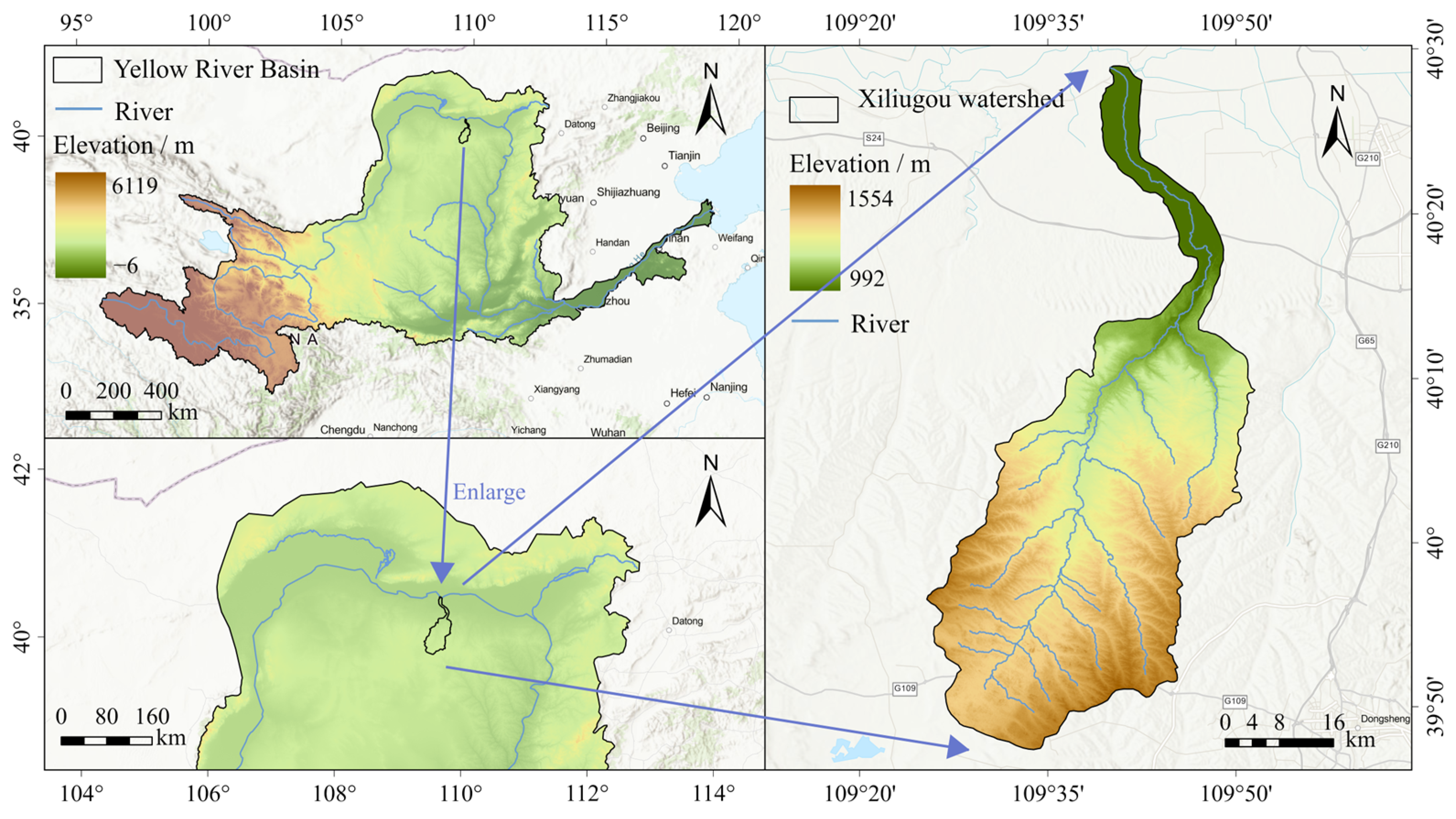


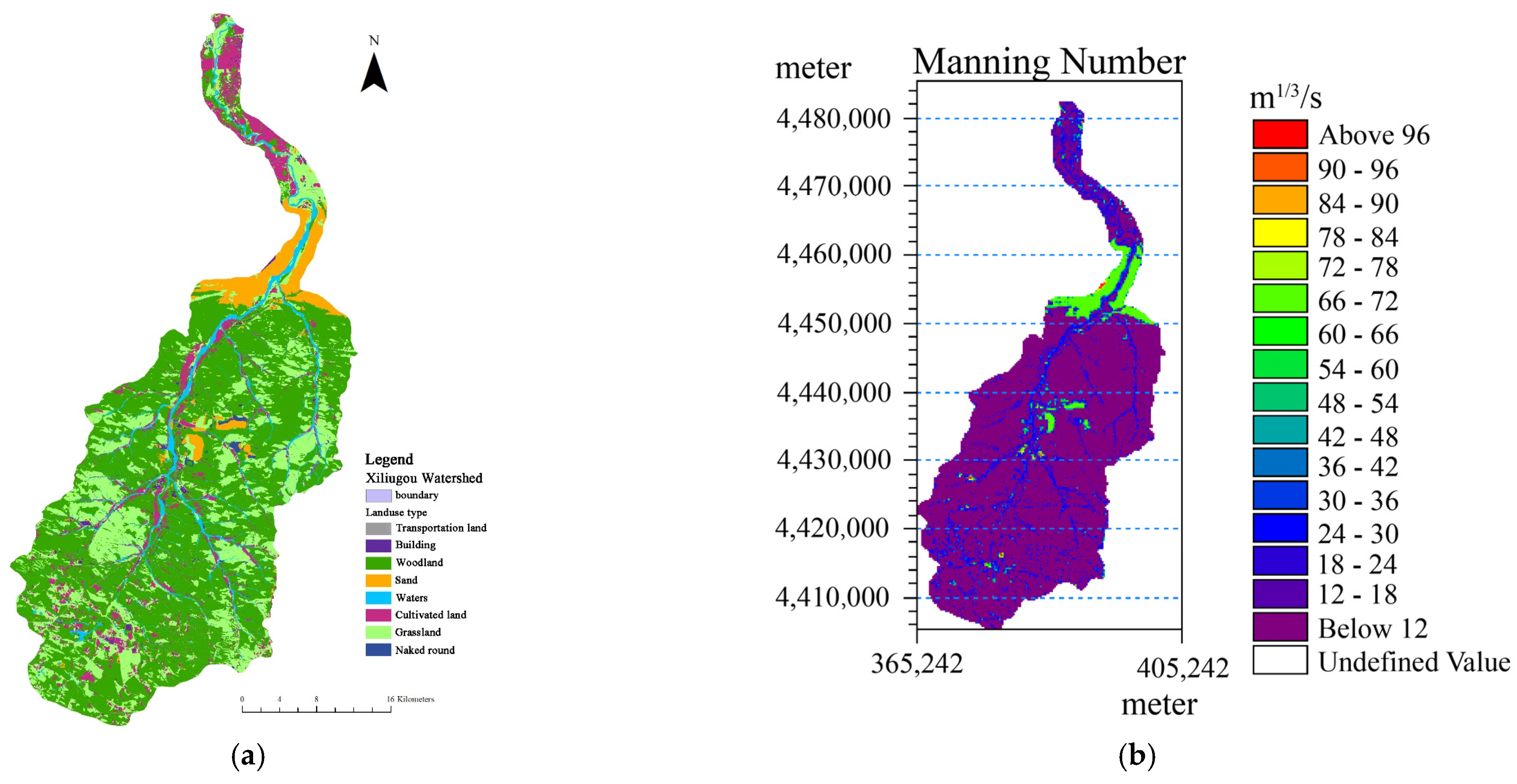
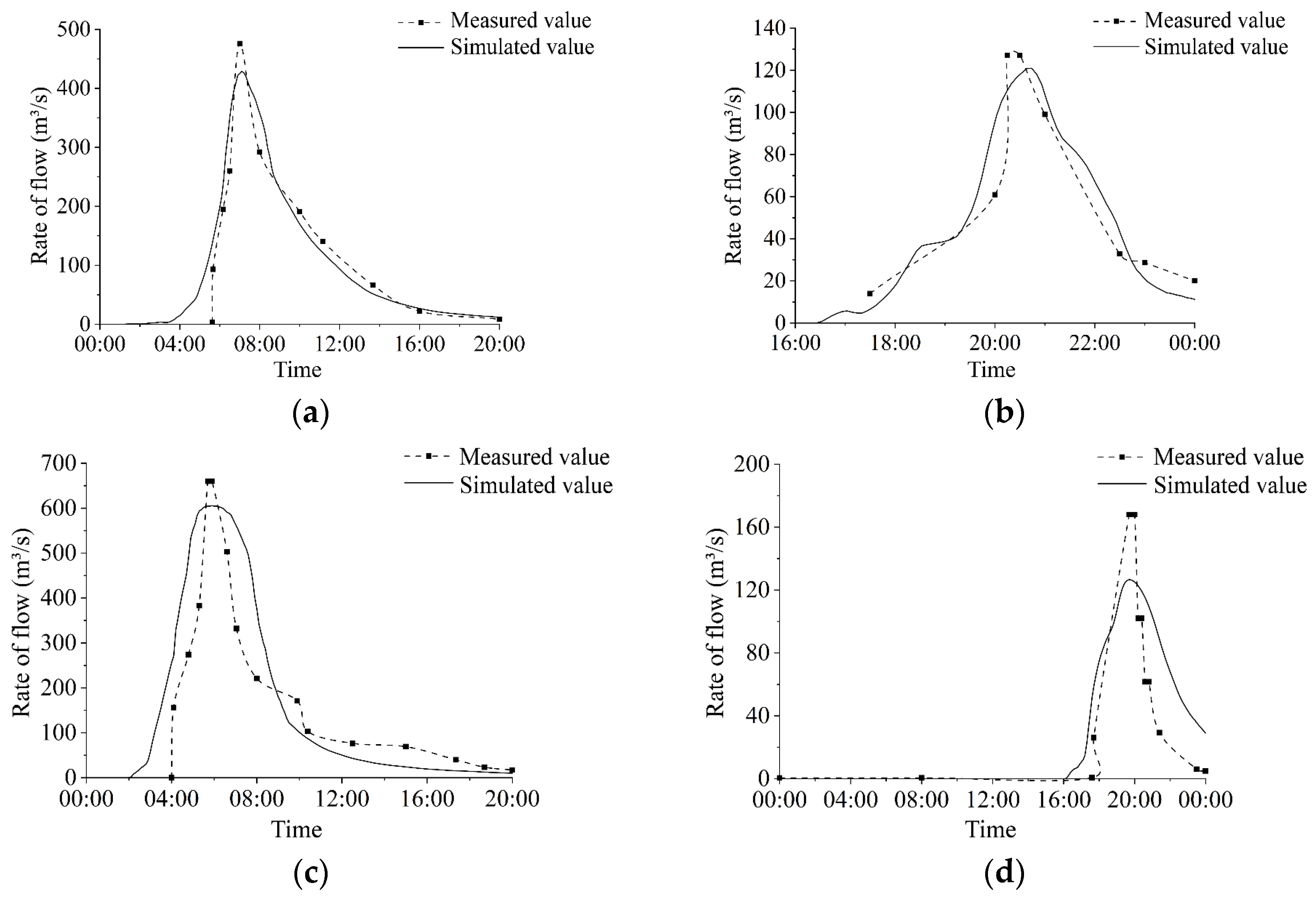



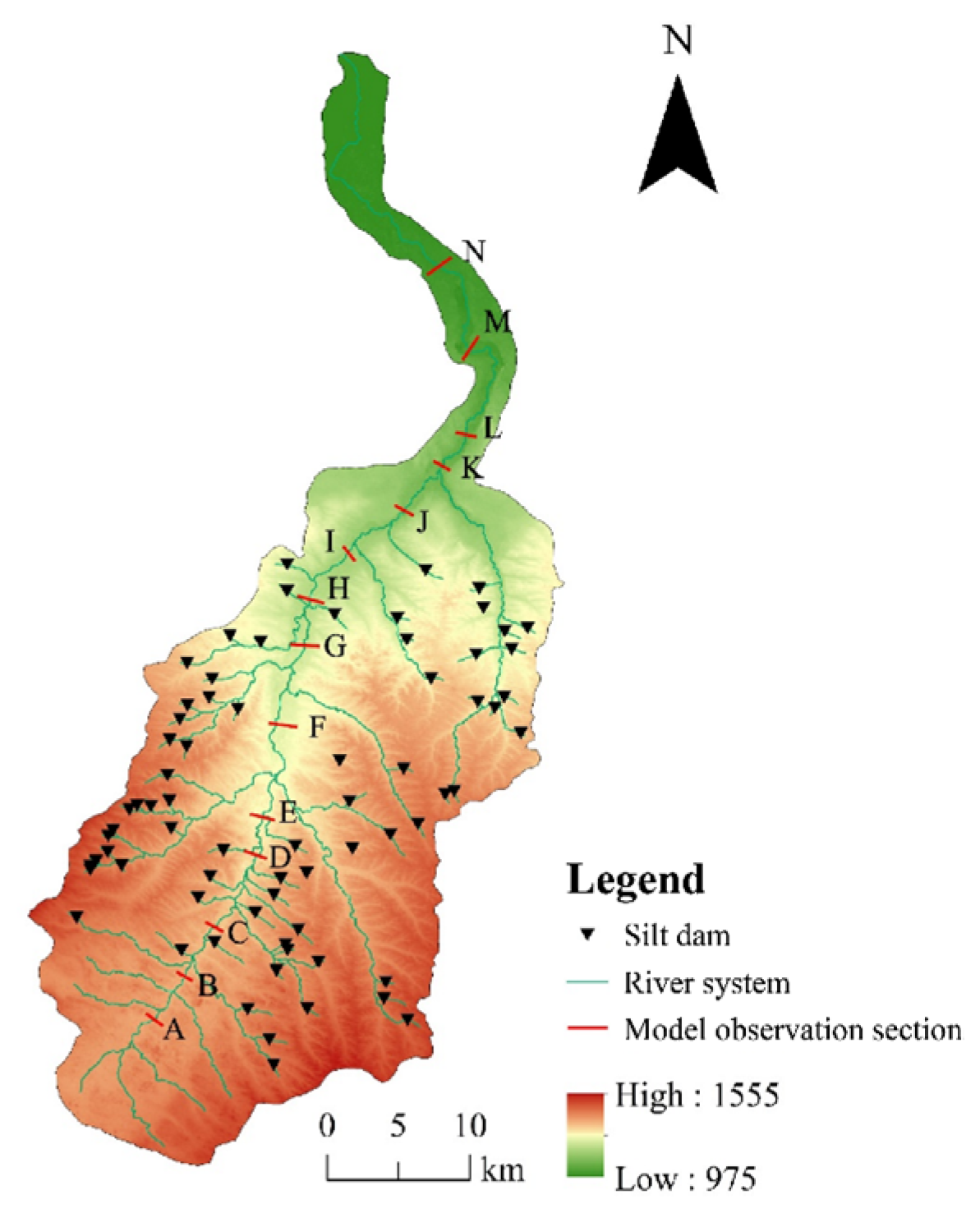



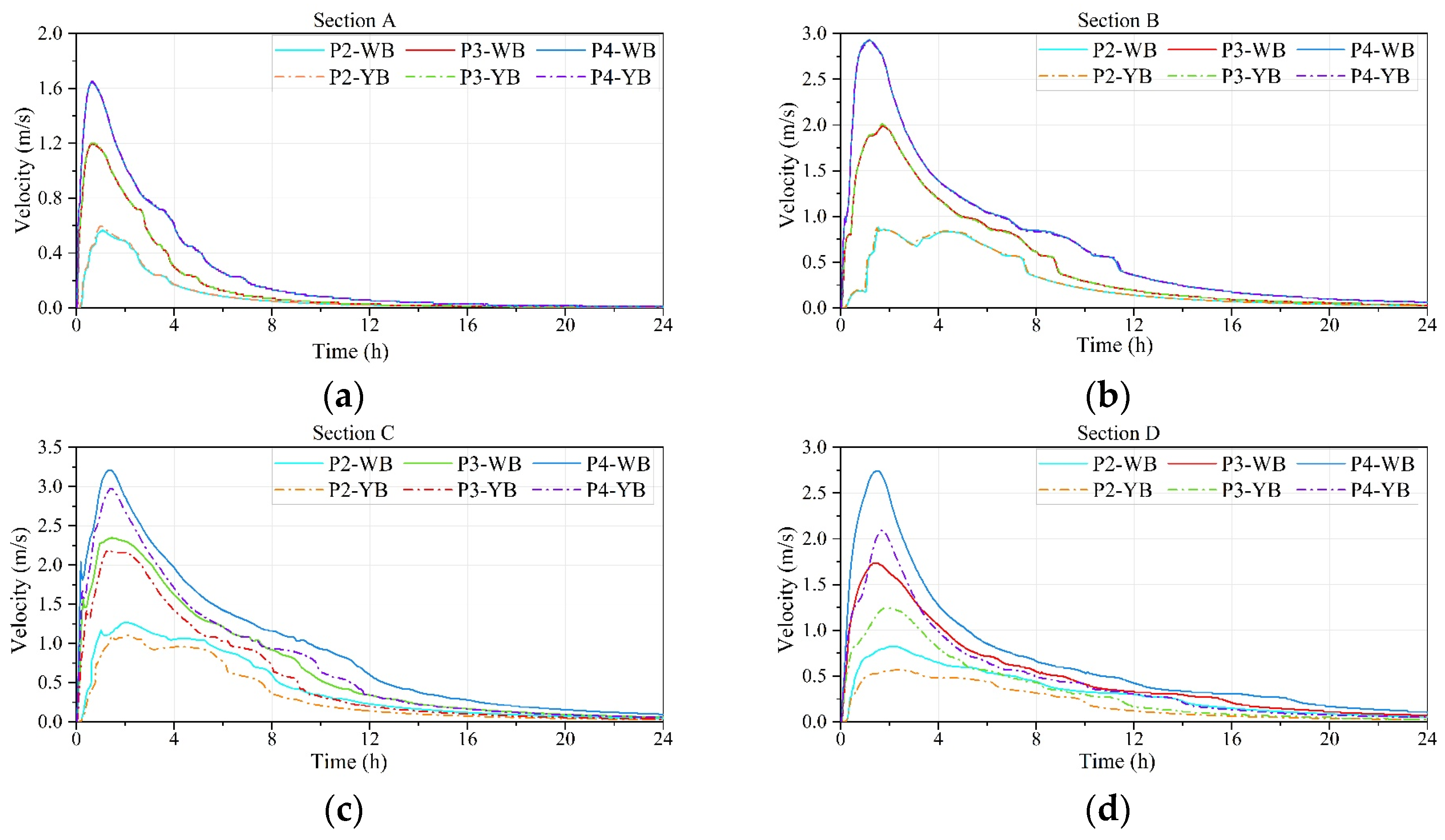
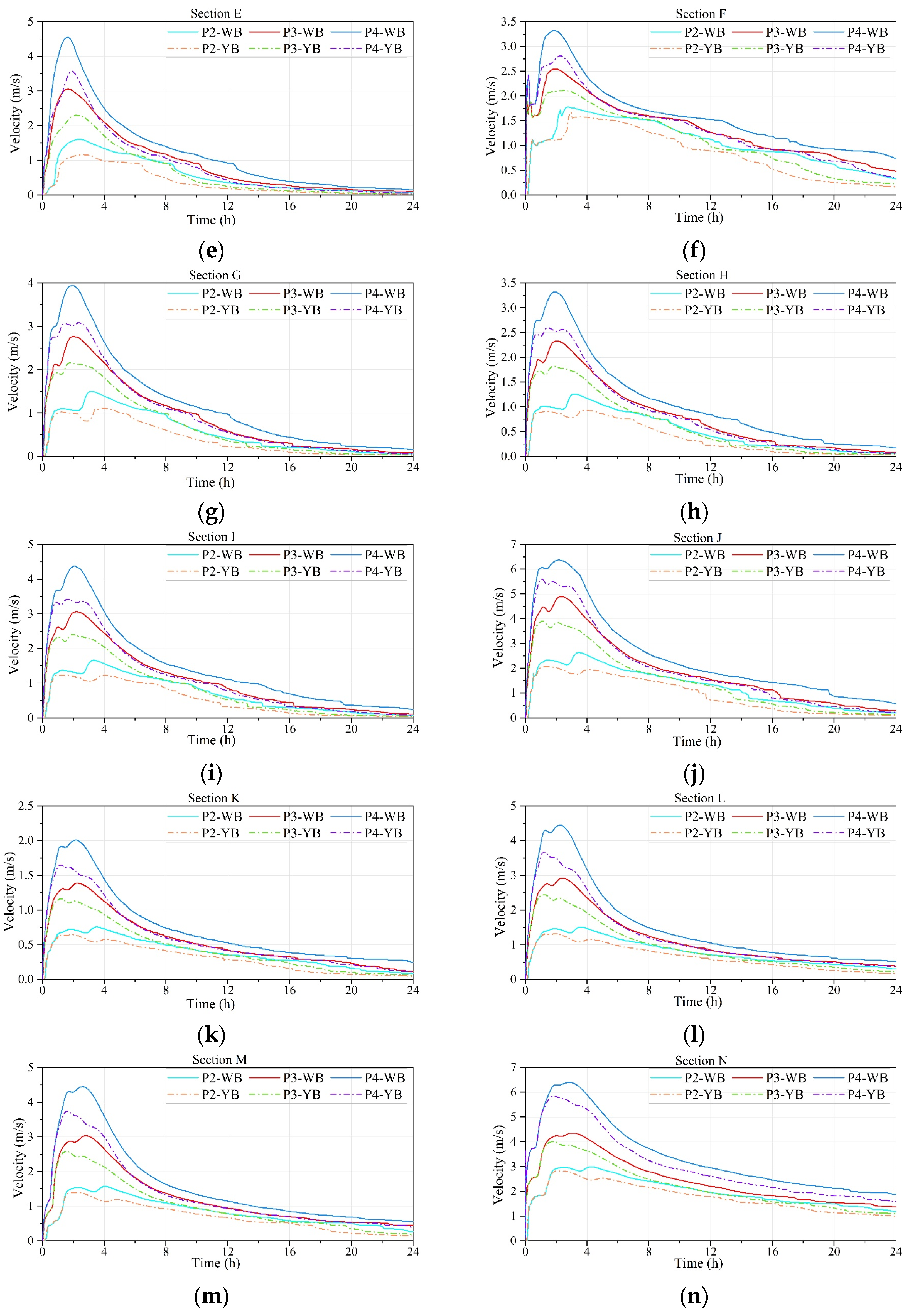

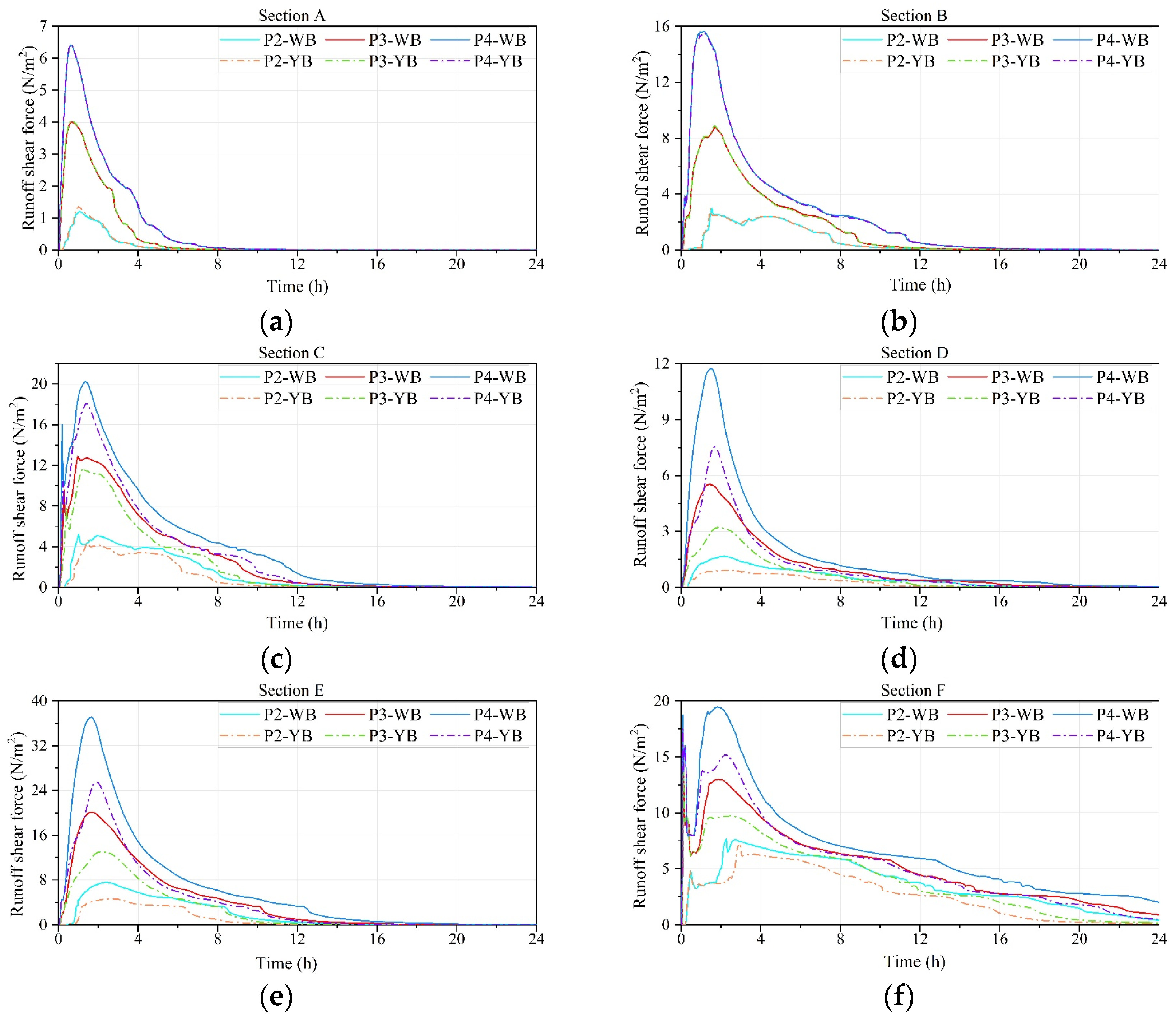
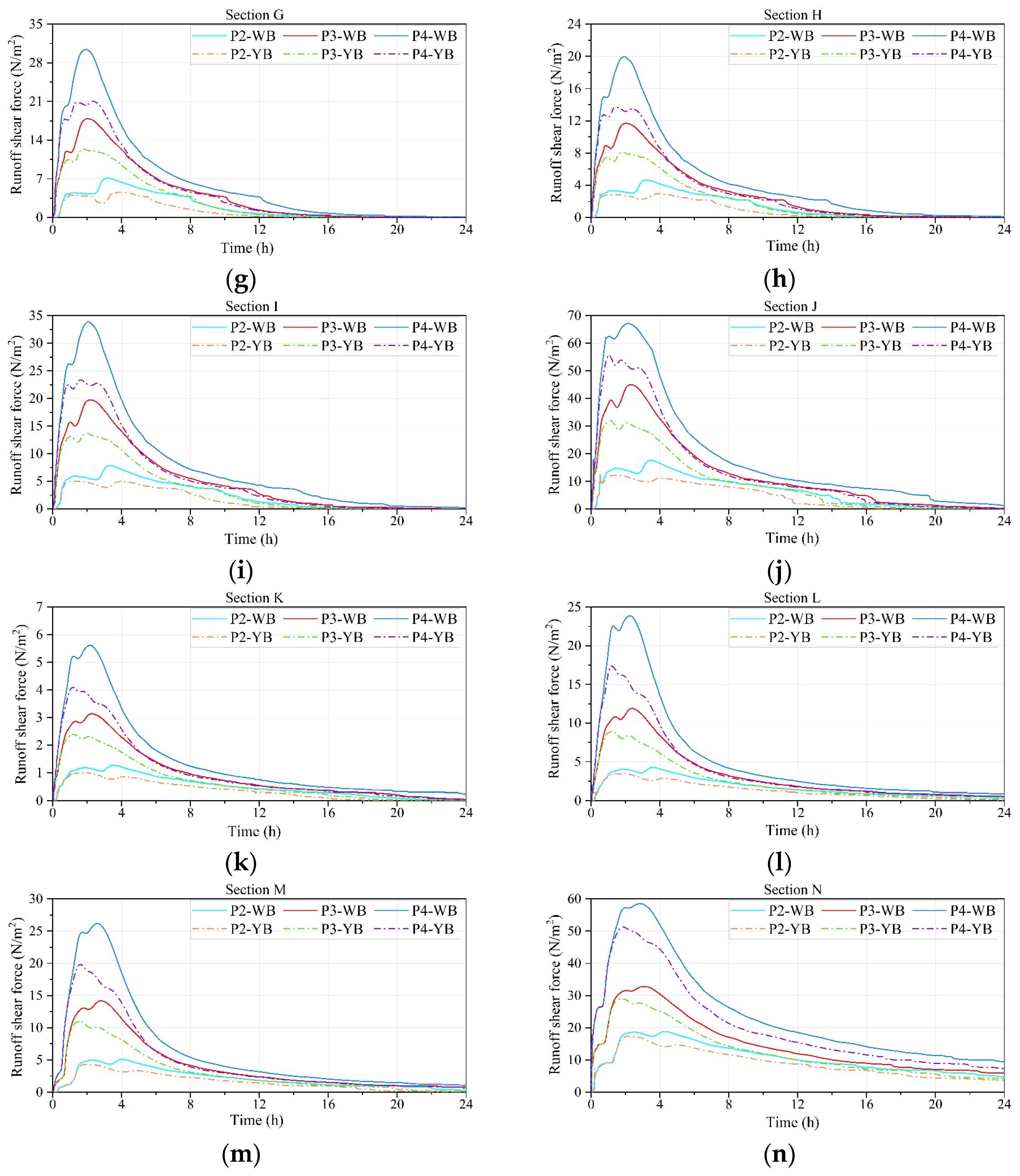
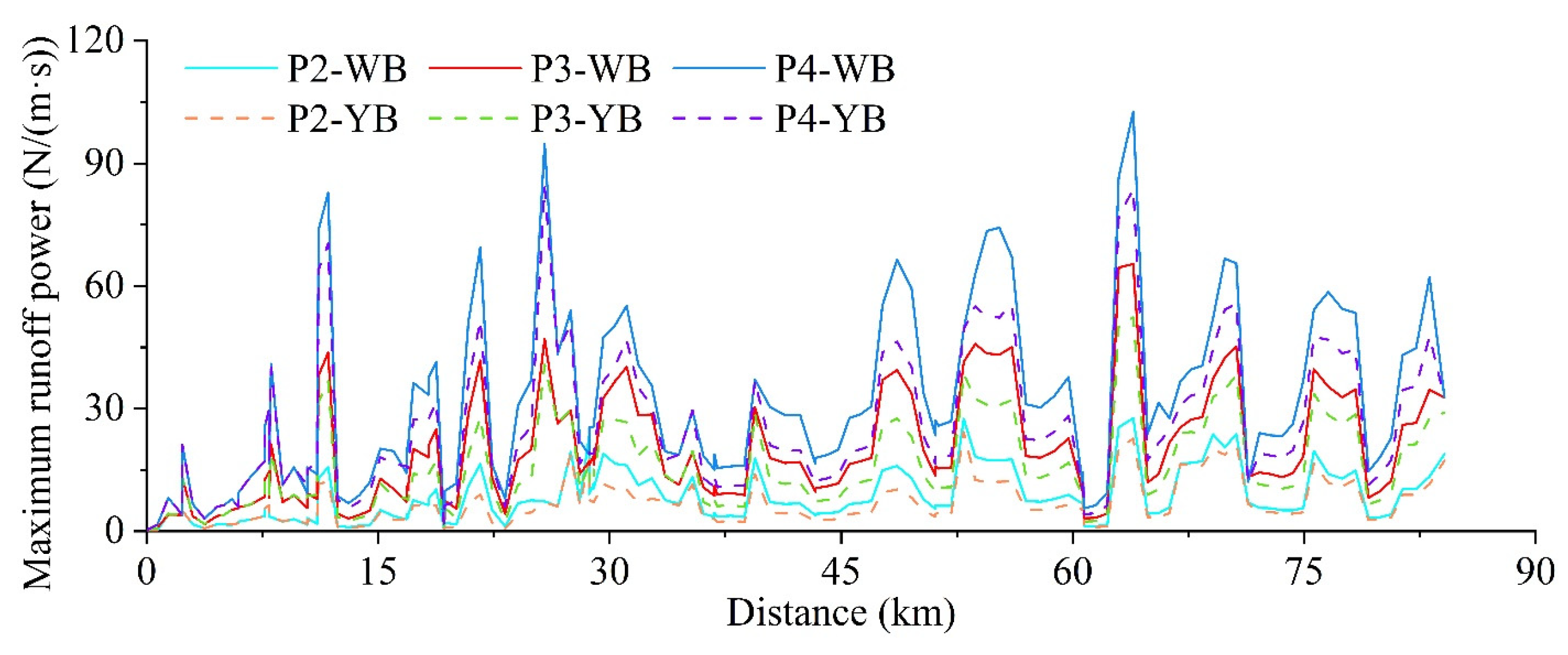


| Land Use Type | Area (km2) | Area Ratio (%) | Manning Coefficient n (s/m1/3) | Gauckler–Strickler Coefficient Ks (m1/3/s) | Infiltration Rate (mm/h) |
|---|---|---|---|---|---|
| Grassland | 278.75 | 23.37 | 0.105 | 9.5 | 2.51 |
| Woodland | 675.01 | 56.58 | 0.250 | 4.0 | 6.00 |
| Bare round | 5.58 | 0.47 | 0.045 | 22.2 | 4.30 |
| Cultivated land | 92.20 | 7.73 | 0.057 | 17.5 | 2.78 |
| Sand | 58.55 | 4.91 | 0.014 | 71.4 | 18.00 |
| Building | 14.17 | 1.19 | 0.010 | 100.0 | 0 |
| Transportation land | 13.60 | 1.14 | 0.017 | 58.8 | 0 |
| Water body (river, lake, reservoir, pond) | 55.06 | 4.62 | 0.033 | 30.3 | - |
| Stage | Flood Code | Actual Flow Measurement Value (m3/s) | Flow Simulation Value (m3/s) | (%) | ||
|---|---|---|---|---|---|---|
| Calibration period | 19,750,811 | 476 | 429 | −9.91 | 0.81 | 0.86 |
| 19,790,911 | 127 | 121 | −4.74 | 0.87 | 0.88 | |
| Verification period | 19,840,809 | 660 | 606 | −8.22 | 0.64 | 0.78 |
| 19,880,626 | 168 | 127 | −11.03 | 0.66 | 0.71 |
| Type | Average Value | Characteristic | Quantity /Field | |
|---|---|---|---|---|
| Total Precipitation/mm | Precipitation Duration/h | |||
| P1 | 3.0 | 1.45 | Small total amount, short duration | 864 |
| P2 | 22.2 | 2.18 | Small total amount, long duration | 132 |
| P3 | 57.4 | 1.08 | Larger total amount, short duration | 19 |
| P4 | 104.2 | 1.00 | Largest total amount, short duration | 2 |
| Precipitation Type | No Check Dams | Check Dams | |||
|---|---|---|---|---|---|
| Average Discharge (m3/s) | (m3/s) | Average Discharge (m3/s) | (m3/s) | Decrease (%) | |
| P2 | 17.05 | 9.19 | 10.33 | 6.81 | 39.41 |
| P3 | 80.50 | 40.85 | 49.48 | 27.06 | 38.54 |
| P4 | 194.62 | 90.51 | 122.48 | 57.98 | 37.07 |
| average | 97.39 | 46.85 | 60.76 | 30.62 | 38.34 |
| Rainfall Type | Working Condition | Average Value (m/s) | Mean Reduction | Peak Value (m/s) | Peak Reduction | (m/s) |
|---|---|---|---|---|---|---|
| P2 | WB | 1.52 | 16.72% | 3.50 | 6.86% | 0.76 |
| YB | 1.27 | 3.26 | 0.66 | |||
| P3 | WB | 2.72 | 15.30% | 6.09 | 14.34% | 1.17 |
| YB | 2.30 | 5.22 | 0.97 | |||
| P4 | WB | 3.76 | 13.84% | 8.32 | 13.28% | 1.50 |
| YB | 3.24 | 7.22 | 1.28 |
| Rainfall Type | Working Condition | Average Value (N/m2) | Mean Reduction | Peak Value (N/m2) | Peak Reduction | (N/m2) |
|---|---|---|---|---|---|---|
| P2 | WB | 8.0 | 21.44% | 27.6 | 12.22% | 6.4 |
| YB | 6.3 | 24.3 | 5.3 | |||
| P3 | WB | 18.5 | 20.49% | 65.4 | 19.99% | 13.4 |
| YB | 14.7 | 52.3 | 10.6 | |||
| P4 | WB | 29.9 | 18.52% | 102.7 | 17.96% | 20.9 |
| YB | 24.4 | 84.2 | 17.3 |
| Rainfall Type | Working Condition | Average Value (N/(m·s)) | Mean Reduction | Peak Value (N/(m·s)) | Peak Reduction | (N/(m·s)) |
|---|---|---|---|---|---|---|
| P2 | WB | 16.93 | 33.10% | 95.98 | 17.68% | 20.71 |
| YB | 11.33 | 79.01 | 15.41 | |||
| P3 | WB | 64.80 | 32.58% | 397.89 | 31.42% | 72.76 |
| YB | 43.68 | 272.88 | 49.24 | |||
| P4 | WB | 140.82 | 29.54% | 854.38 | 29.30% | 150.29 |
| YB | 99.22 | 604.02 | 108.37 |
Disclaimer/Publisher’s Note: The statements, opinions and data contained in all publications are solely those of the individual author(s) and contributor(s) and not of MDPI and/or the editor(s). MDPI and/or the editor(s) disclaim responsibility for any injury to people or property resulting from any ideas, methods, instructions or products referred to in the content. |
© 2025 by the authors. Licensee MDPI, Basel, Switzerland. This article is an open access article distributed under the terms and conditions of the Creative Commons Attribution (CC BY) license (https://creativecommons.org/licenses/by/4.0/).
Share and Cite
Zhang, N.; Feng, Y.; Xia, Z.; Li, P.; Yue, F.; Cao, Y.; Wang, P.; Wang, T.; Guo, X.; Zhou, S. The Effects of Runoff and Erosion Hydrodynamics by Check Dams Under Different Precipitation Types in the Watershed of Loess Plateau. Water 2025, 17, 947. https://doi.org/10.3390/w17070947
Zhang N, Feng Y, Xia Z, Li P, Yue F, Cao Y, Wang P, Wang T, Guo X, Zhou S. The Effects of Runoff and Erosion Hydrodynamics by Check Dams Under Different Precipitation Types in the Watershed of Loess Plateau. Water. 2025; 17(7):947. https://doi.org/10.3390/w17070947
Chicago/Turabian StyleZhang, Naichang, Yangfan Feng, Zhaohui Xia, Peng Li, Fan Yue, Yongxiang Cao, Pengfei Wang, Tian Wang, Xingyue Guo, and Shixuan Zhou. 2025. "The Effects of Runoff and Erosion Hydrodynamics by Check Dams Under Different Precipitation Types in the Watershed of Loess Plateau" Water 17, no. 7: 947. https://doi.org/10.3390/w17070947
APA StyleZhang, N., Feng, Y., Xia, Z., Li, P., Yue, F., Cao, Y., Wang, P., Wang, T., Guo, X., & Zhou, S. (2025). The Effects of Runoff and Erosion Hydrodynamics by Check Dams Under Different Precipitation Types in the Watershed of Loess Plateau. Water, 17(7), 947. https://doi.org/10.3390/w17070947







